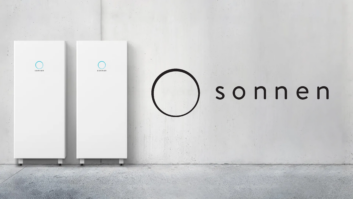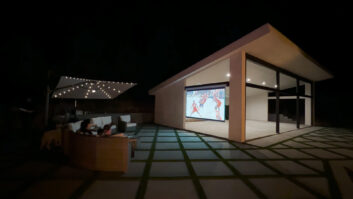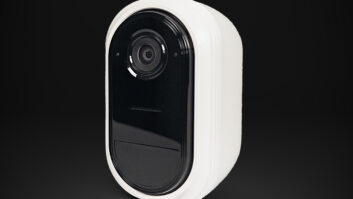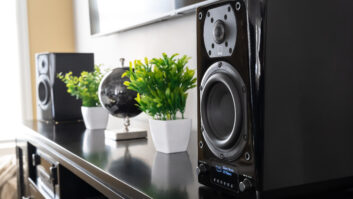In my last column I wrote an overview of the new Control4-certified 1000-square-foot townhouse that cyberManor built to showcase the latest, cutting-edge home automation and energy management solutions. This home features 210 square feet of southeast-facing Suniva solar panels optimized by a TiGo Energy Maximizer management unit. These solar panels charge our sonnen EcoLinx 10 kWh smart battery, which satisfies almost all of the electricity requirements for our townhouse showroom.
Check out part one of this story: Energy Management Solutions for Smarter Living
In this column we will review the results of our summer testing of the sonnen EcoLinx 10KWH battery that has powered our new showroom.
A typical summer day’s performance is shown in the daily performance graph (figure 1). Our sonnen EcoLinx 10 battery energy management system’s backup buffer was set to 10 percent, meaning that 10 percent of the system’s capacity, or 1 kWh, is always on reserve in case of a power interruption. At 10 percent buffer the sonnen ecoLinx battery is capable of powering the critical loads we defined in our home; including the networking equipment, garage door, and irrigation systems.

We also programmed the sonnen EcoLinx battery to discharge during peak hours from 12:00 pm to 6:00 pm (when energy rates are high), as well as from 6:00 pm to 6:00 am (which, while technically partial peak and off-peak, allows us to power the showroom with stored energy instead of relying on the grid).
As you can see in figure 1, the battery charges in the morning (beginning at 6:00 am) from a combination of solar energy (shown in yellow) and grid power. Currently, the grid can augment the solar production during these off-peak times at a net rate of about 1 kWh per battery module in our sonnen EcoLinx system (after a DC-to-AC conversion loss of about 250 Wh, we have a total of five 2 kWh battery modules charging at a fixed rate of 250 Wh.)
At 8:51 am our PV production was 1379 W and our load consumption was only 179 W — therefore 1,200 W of solar energy was stored in the sonnen EcoLinx battery. Coupled with the approximate 1000 W of energy received from the grid, the net rate of charge at that time was 2,158 W. By this time in the morning, the sonnen EcoLinx battery was almost half charged (State of Charge (SOC) is shown at 46 percent), with only about 5 kWh remaining to reach 100 percent state of charge. At the charging rate of 2 kWh per hour, the battery was fully charged by about 10:30 am. Ultimately, the goal each day is to use both solar and grid energy to fully charge the 10 kWh battery by noon (when peak energy rates take effect), as shown in the figure 1.
Then, beginning at noon, the battery begins to discharge to meet the showroom’s energy needs (consumption loads are shown in blue, battery discharge is shown in red). Here, the graph demonstrates the battery discharging in the early afternoon (when it typically charges off of excess solar), representing a period of time when energy consumption exceeded solar production. Then, once solar production was able to meet the energy consumption needs and provide excess energy, the battery began to charge from the solar panels again. As the afternoon and evening progressed, the battery slowly discharged until the early morning hours when it reached a 10 percent state-of-charge (at which point it does not discharge any further since it is programmed to always maintain a 10 percent backup power reserve).
The author and the sonnen EcoLinx battery.
The rooftop solar panels.
Top view of the living room.
The living room.
After reaching the reserve charge of 10 percent, solar and/or grid energy is used to charge the showroom until there is enough excess solar energy to once again charge the sonnen EcoLinx battery using this clean energy.
In addition, in order to reduce summer daily energy consumption, the Control4 system is programmed to create a “summer natural cooling scene” to minimize air conditioner run time. This is accomplished by controlling the following intelligent subsystems to provide convective cooling when the showroom temperature hits 77 degrees:
- Turn on the Haiku intelligent fan to provide convection cooling
- Electronically open the Velux intelligent skylights to vent the hot ceiling air outside
Future sonnen/Control4 Performance Enhancements
The sonnen ecoLinx energy management system will have the ability to change its grid charging rate from 250 W per battery to 800 W per battery. This will allow the battery to accelerate its charge rate during off-peak hours to accommodate for cloudy and/or high energy consumption days. sonnen is also currently working with software developers to develop a backup buffer and grid charging rate scheduler that will examine the upcoming day’s weather forecast and home’s energy consumption patterns to optimize the backup buffer level.
For example, based on typical low energy consumption and a predicted, sunny weather forecast, the backup buffer should remain at a low percentage to maximize daily energy cycling of the battery. On the other hand, if it is projected to be a cloudy day, and if there is a normal level of predicted energy consumption, the backup buffer should increase to ensure that the battery is fully charged for use during the following days peak electrical rate hours.
It is a very empowering feeling watching our solar PV/sonnen battery storage system power all the electrical energy needs of our townhouse showroom. To know that all the electronics that we typically install in our client’s homes — audio/video, lighting, comfort control, and security — can now be powered all day/evening and during power outages using only clean energy. The EcoLinx battery enables us to promote our total home technology solutions as zero carbon footprint solutions.











